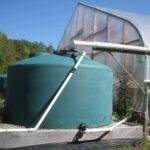Renewing Rainwater From High Tunnels

Water, one of the basic necessities of plants, and, for that matter, any life form, falls naturally to sustain growth. Plants grown in high tunnels, however, are excluded from the naturally occurring irrigation that is rainfall, and thus, need to be artificially pumped with H2O to survive. This process can be costly, as Dr. Lewis Jett of West Virginia University explains, as a commercial-size high tunnel can
displace more than 1,800 gallons of water per one inch of rainfall. With so much needed input, he poses the question, why not make high tunnels more self-sufficient by capturing rainfall? In the following, Jett explains the Who, What, When, Where, and Why of this environmentally friendly approach to irrigation.
Who can use this method?
Having tested this method on both fruit and vegetable crops, Jett says that it is functional regardless of the crop. Explaining that many horticulture crops require as much as 1½ inches of water per week for optimal yields, Jett feels confident that if rainfall is adequate, this is a strong option for growers looking to cut costs for water usage. That “If” is a big one, though. Suggesting that growers think of this method more as a back-up supply than a primary source of water, he says that both mixed and monoculture crops are good candidates for this method. “When used as a secondary source to traditional irrigation sources,” he says, “we cut irrigation cycles by a third.”
What is needed to start collecting rainwater off of high tunnels?
To set up a water collection system, Jett says that a vinyl rain gutter should be mounted to the hip board of the high tunnel on both sides. Runoff water will be collected by these gutters and channeled into storage tanks with 500 to 1,500 gallons of capacity on either side. Harvested rainwater, he says, can then be pumped into the drip lines which are placed down each row or bed within the high tunnel.
Another option, though, is that the tank be elevated above the irrigation lines to utilize gravity for water movement. Jett goes on to explain that a screen filter should also be placed over the inlet of the water tank to keep pollen, leaves, and other debris out. A disc filter will also be needed on the main irrigation line to provide additional filtration.
After the rainwater is collected, it can be pumped into the mainline, which is the header pipe feeding each drip line or gravity-fed if the catchment tank is elevated enough. Jett also says that a solar or gasoline pump can be used if desired.
When will the rainwater capturing system pay itself off?
Jett recognizes that growers have cited the cost of the above-ground storage tank as a deterrent to using this system. Explaining that the larger tanks can be very costly (running about 50¢ to 80¢ per gallon) and thus not a practical way to save money, he says that there is a point where it becomes uneconomical to store water. He does explain, however, that using rainfall as a supplement to municipal, surface or well water can reduce the number of irrigation cycles by 33% to 50% in a temperate region with more than 40 inches of annual rainfall per year. What this means, he explains, is that growers need to carefully consider their location, the reliability of their current system, and other important factors before committing to a catchment system.
Where does this method work best?
As different parts of the country receive different amounts of rainfall, it is important to understand that these percentages are not a one-size-fits-all for growers in the U.S. Jett says that this system works best as a primary source for areas with relatively uniform seasonal rainfall, as growers can better rely on having water in the tank when it is needed. This can be used as a secondary source of water, though, in areas with unpredictable rainfall.
Why would a grower choose to use this system?
Growers have different motivations for wanting to capture rainwater off of high tunnels, explains Jett. From wanting to lessen their carbon footprint to having an unreliable traditional water source such as surface water that goes dry, or hard water and even the basic cost of water usage, there are many reasons to choose to harvest rain. He does emphasize, however, that despite the reasoning for trying this system, growers should be careful to test their water accordingly. Recommending that all water be tested for hardness and pH, he also says that it is important that rainwater be microbial tested for bacteria such as E. coli. In addition, Jett says that growers should consider adding a small amount of chlorine to prevent algae growth, particularly if the water is being stored in above-ground tanks.





